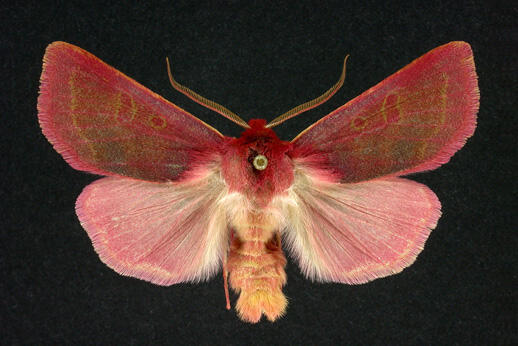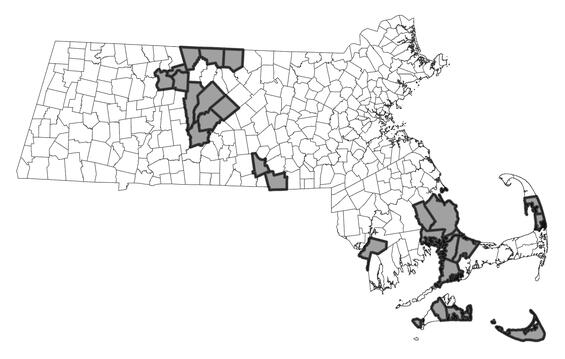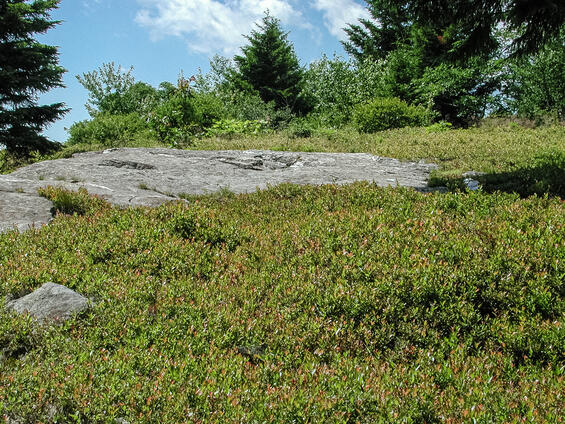- Scientific name: Psectraglaea carnosa
- Species of Greatest Conservation Need (MA State Wildlife Action Plan)
- Special Concern (MA Endangered Species Act)
Description

Pink sallow (Psectraglaea carnosa)
The pink sallow (Psectraglaea carnosa) is a noctuid moth with a wingspan of 38-45 mm (1.5-1.8 in) (Forbes 1954). The forewing is bright, reddish pink; a variable amount of gray shading may be present from the median area to the inner margin. A faint yellow subterminal line is present, and the reniform and orbicular spots are faintly outlined in yellow. The hind wings are light tan in color, shaded with pink. The head and thorax are concolorous with the reddish pink of the forewings, and the abdomen is light tan shaded with pink, similar in color to the hind wings.
Life cycle and behavior

Adult pink sallow moths fly in late September and October. Eggs overwinter, hatching in spring. Larvae feed on lowbush blueberries (Vaccinium angustifolium and V. pallidum), and possibly other Vaccinium species, from spring through early summer. Larvae complete development and pupate in late June or July and enter diapause until autumn.
Distribution and abundance
The pink sallow moth is endemic to northeastern North America, ranging from Maine south to Maryland, and west to Pennsylvania, Michigan, and Wisconsin; it is rare and spottily distributed throughout this range (Schweitzer et al. 2011). In Massachusetts, this species occurs on the southeast coastal plain, as well as in Worcester and Franklin Counties.

Distribution in Massachusetts.
1999-2024
Based on records in the Natural Heritage Database.
Habitat
The pink sallow moth is found in a variety of habitats with lowbush blueberries, including pitch-pine scrub oak barrens and heathlands on sandplains or rocky summits and ridges, acidic bogs and swamps, and occasionally logged areas, old fields, or utility line rights-of-way.
Healthy habitats are vital for supporting native wildlife and plants. Explore habitats and learn about conservation and restoration in Massachusetts.

Ridgetop heathland habitat with abundant lowbush blueberries, ideal habitat for the pink sallow moth.
Threats
The pink sallow moth is threatened by habitat loss and fire suppression in its disturbance-dependent habitats, in particular sandplain and ridgetop pitch pine-scrub oak barrens and heathlands. Other potential threats include introduced generalist parasitoids, aerial insecticide spraying, non-target herbicide application, and off-road vehicles. In its wetland habitats, hydrologic alteration, invasion by exotic plants, and eutrophication or other water pollution are potential threats. A warming climate may be detrimental to this species, as its range has a narrow latitudinal extent, extending south only to Maryland. Northward range expansion may be possible, though this has not yet been documented.
Conservation
Land protection and habitat management are the primary conservation needs of this species in Massachusetts. In particular, sandplain and ridgetop pitch pine-scrub oak barrens and heathlands should be conserved, restored, and managed to maintain habitat for this species and the entire suite of rare and threatened species dependent on such habitats.
Survey and monitoring
The distribution of the pink sallow moth in sandplain pitch pine-scrub oak barrens and heathlands is well documented. However, ridgetop pitch pine-scrub oak barrens and heathlands in western Massachusetts are likely under surveyed for this species. Known populations of this species should be surveyed to document persistence at least once every 25 years; every 10 years is more desirable when practicable.
Management
Management of sandplain and ridgetop pitch pine-scrub oak barrens and heathlands benefits a suite of rare and threatened species, and habitat condition should be monitored and management adapted as needed. For the pink sallow moth, open barrens with a shrub layer including lowbush blueberries (Vaccinium angustifolium and V. pallidum) is of particular importance.
Research needs
The natural history and conservation needs of the pink sallow moth are relatively well known. However, the future effects of a warming climate on this species are unpredictable and should be documented.
References
Forbes, W.T.M. 1954. Lepidoptera of New York and Neighboring States. Part III. Memoir 329, Cornell University Agricultural Experiment Station, Ithaca, New York. 433 pp.
Schweitzer, D.F., M.C. Minno, and D.L. Wagner. 2011. Rare, Declining, and Poorly Known Butterflies and moths (Lepidoptera) of Forests and Woodlands in the Eastern United States. Forest Service, U.S. Dept. of Agriculture, Washington, DC. 517 pp.
Contact
| Date published: | March 7, 2025 |
|---|